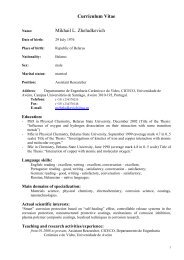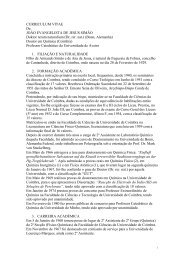XII Iberian Meeting of Electrochemistry XVI Meeting of the ...
XII Iberian Meeting of Electrochemistry XVI Meeting of the ...
XII Iberian Meeting of Electrochemistry XVI Meeting of the ...
Create successful ePaper yourself
Turn your PDF publications into a flip-book with our unique Google optimized e-Paper software.
<strong>XII</strong> <strong>Iberian</strong> <strong>Meeting</strong> <strong>of</strong> <strong>Electrochemistry</strong> & <strong>XVI</strong> <strong>Meeting</strong> <strong>of</strong> <strong>the</strong> Portuguese Electrochemical Society PB 07<br />
Electrochemiluminescence <strong>of</strong> luminol/H 2 O 2 system catalyzed<br />
by ferrocenes derivatives in solution on I T O electrode<br />
Diogo Ramadas 1,2 , Ana S. Viana 2 , A.C. Cascalheira 1<br />
1 Lumisense,Lda, Edifício ICAT, Campo Grande, 1749-016 Lisboa, Portugal<br />
2 CQB, Departamento de Química e Bioquímica, Faculdade de Ciências da Universidade de Lisboa,<br />
Campo Grande, 1749-016 Lisboa, Portugal<br />
drsousa@fc.ul.pt<br />
Luminol is one <strong>of</strong> <strong>the</strong> earliest known syn<strong>the</strong>tic compounds exhibiting<br />
chemiluminescence and has been extensively studied regarding its analytical<br />
applications. The employment <strong>of</strong> electrochemiluminescence (ECL) <strong>of</strong> luminol systems<br />
onto analytical determinations suffers from a continuous decrease <strong>of</strong> <strong>the</strong> light signal<br />
during consecutive electrode perturbation, which results on poor reproducibility [1]. The<br />
decrease in <strong>the</strong> signal has been attributed to <strong>the</strong> electrode fouling/passivation due to<br />
deposition <strong>of</strong> poisoning compounds, products <strong>of</strong> <strong>the</strong> ECL reaction. The use <strong>of</strong> ferrocene<br />
derivatives as catalysts in <strong>the</strong> ECL <strong>of</strong> luminol/H 2 O 2 system was investigated on several<br />
authors in various electrode materials [2-4]. Most <strong>of</strong> those studies concern <strong>the</strong> use <strong>of</strong><br />
ferrocene derivatives as labels for biomolecules and optical ECL detection. However,<br />
since <strong>the</strong>se derivatives can also function as mediators for <strong>the</strong> ECL reaction it can be<br />
envisaged that <strong>the</strong>y can prevent <strong>the</strong> electrode fouling and consecutively increase <strong>the</strong><br />
stability <strong>of</strong> ECL systems based on <strong>the</strong> luminol reaction.<br />
In this study, we compare <strong>the</strong> ECL response <strong>of</strong> an alkaline solution <strong>of</strong> luminol and H 2 O 2<br />
in <strong>the</strong> presence <strong>of</strong> three different ferrocene derivatives (ferrocene monocarboxylic acid,<br />
ferrocene dicarboxylic acid, ferrocene carboxaldehyde) onto a ITO electrode, by linear<br />
voltammetry or potential pulse application. The obtained results indicate that ferrocene<br />
monocarboxylic acid is <strong>the</strong> most promising derivative, since it catalyzes <strong>the</strong> reaction by<br />
120 mV; <strong>the</strong> light emission <strong>of</strong> <strong>the</strong> system without ferrocene starts at 360mV (vs. SCE)<br />
whereas in <strong>the</strong> presence this mediator can be detected at 240mV (vs. SCE). The recorded<br />
currents corroborate <strong>the</strong> optical results revealing that <strong>the</strong> onset <strong>of</strong> <strong>the</strong> optical signal<br />
corresponds to <strong>the</strong> beginning <strong>of</strong> <strong>the</strong> oxidation <strong>of</strong> <strong>the</strong> ferrocene derivatives. A systematic<br />
studied has been also performed in order to study <strong>the</strong> influence <strong>of</strong> <strong>the</strong>: ratio<br />
concentration <strong>of</strong> Ferrocene/Luminol, pH, and buffer nature on <strong>the</strong> reproducibility and<br />
intensity <strong>of</strong> <strong>the</strong> optical signal.<br />
Acknowledgments: Diogo Ramadas acknowledge Fundação para Ciência e Tecnologia, for<br />
financial support, project SFRH / BDE / 33797 / 2009<br />
References<br />
[1] C. A. Marquettc and L.J. Blum. Anal. Chim. Acta , 1999, 381, p. 1<br />
[2] R. Wilson and D. Schiffrin. J. Electroanal. Chem., 1998, 448, p. 125<br />
[3] R. Wilson and D. Schiffrin. Anal. Chem., 1996, 68, p. 1254<br />
[4] C. E. Taylor, Stephen E. Creager, J.Electroanal.Chem., 2000, 485, p. 114<br />
September, 811, 2010. ISEL - Lisbon 73








